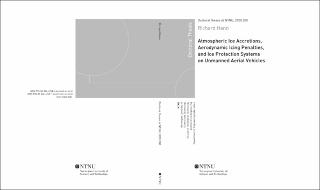| dc.contributor.advisor | Johansen, Tor Arne | |
| dc.contributor.advisor | Storvold, Rune | |
| dc.contributor.author | Hann, Richard | |
| dc.date.accessioned | 2020-06-11T07:28:38Z | |
| dc.date.available | 2020-06-11T07:28:38Z | |
| dc.date.issued | 2020 | |
| dc.identifier.isbn | 978-82-326-4749-1 | |
| dc.identifier.issn | 1503-8181 | |
| dc.identifier.uri | https://hdl.handle.net/11250/2657638 | |
| dc.description.abstract | This thesis focused on atmospheric ice accretions, aerodynamic icing penalties, and ice protection systems (IPS) on fixed-wing unmanned aerial vehicles (UAVs). The motivation for this work was to increase the knowledge about the mechanisms and effects of atmospheric in-flight icing on UAVs. These insights were directed to aid in the development of systems to mitigate the adverse effects of icing on UAVs. Therefore, this thesis aimed to answer the following questions: Why is icing on UAVs a problem? What are the specific issues of icing on UAVs? How can we predict ice accretions on UAVs? What impacts does icing have on UAVs? How can we protect UAVs from icing? And, how much energy is required for an active UAV IPS?
The methods of this thesis included experimental tests and numerical simulations. Four experimental campaigns were conducted in the scope of this work. Icing wind tunnel tests were performed at Cranfield University in fall 2018 and at the facilities of the Technical Research Centre of Finland (VTT) in spring and fall 2019. Conventional wind tunnel tests with artificial ice shapes were conducted in summer 2019 in the fluid mechanics laboratory at the Norwegian University of Science and Technology (NTNU). Numerical simulations were conducted with LEWICE (2D) and FENSAP-ICE.
The first objective of this thesis was to investigate the special issues related to icing on UAVs and to identify differences to icing on manned aircraft. This included technical aspects originating from disparities in airframe size, airspeed, propulsion, mission objectives, etc. Operational challenges included differences in icing environments, difficulties in icing forecasting, and path-planning. Furthermore, an overview was given over general topics related to icing detection, IPS, icing wind tunnels, and simulation methods of icing for UAVs. Also, wind turbine icing was highlighted as a research field with significant similarities and potential synergies with UAV icing.
The second objective of the thesis was to collect experimental ice shapes from icing wind tunnel tests and compare them to numerical icing simulations. This work was relevant because the numerical methods used in this thesis have originally been developed for manned aircraft applications and were not validated for UAVs. One of the main concerns was the difference in the Reynolds number regime, which for UAVs is about an order of magnitude lower than for manned aircraft. The comparison between numerical and experimental ice shapes revealed significant limitations of the codes. In general, both numerical simulation tools seemed to predict lower ice masses, smaller icing limits, and smoother ice shapes. The smallest deviations occurred for rime ice, the largest for glaze, especially for LEWICE. In general, FENSAP-ICE offered better results with a sufficient level of similarity to the experimental ice shapes. LEWICE showed more limitations, especially with regards to the shape and complexity of the ice shapes.
The third objective of the thesis was to investigate the effects of icing on the aerodynamic performance of UAVs. This work included a comparison of FENSAP-ICE to experiments with artificial ice shapes at low Reynolds numbers. This validation showcased the accuracy and the limitations of the numerical method, the latter which existed especially for flow conditions with large separations. Following this validation, two numerical studies were performed. One to identify the most hazardous meteorological icing conditions for UAVs, and the other to investigate the influence of airspeed and airfoil size on performance penalties. These studies showed that UAVs are more sensitive to icing conditions than manned aircraft and that the most hazardous conditions occur near the freezing point and in conditions with high water content.
The fourth and final part of this thesis focused on an electrothermal IPS for UAVs and the required heat loads for anti-icing and de-icing. A numerical study using LEWICE and FENSAP-ICE was conducted to investigate the differences between running-wet and fully-evaporative anti-icing systems, showing that running-wet was more efficient. Furthermore, an experimental campaign was conducted to test anti-icing, ice detection, and autonomous operation on a UAV IPS. Another experimental study was performed focusing on determining the heat loads for anti-icing and de-icing. A variety of icing and IPS parameters were tested on two different IPS systems (conventional and parting strip). The results showed that the least energy-efficient operation of the IPS was anti-icing. De-icing was substantially more efficient, especially at low temperatures. De-icing with a parting strip was shown to be the most efficient IPS mode. | en_US |
| dc.language.iso | eng | en_US |
| dc.publisher | NTNU | en_US |
| dc.relation.ispartofseries | Doctoral theses at NTNU;2020:200 | |
| dc.relation.haspart | Hann, R., Johansen, T.A.: Unsettled Topics in Unmanned Aerial Vehicle
Icing. SAE International, SAE EDGE Research Report, EPR2020008, 2020. | |
| dc.relation.haspart | Hann, R., Hearst, R.J., Sætran, L., Bracchi, T.: Experimental and
Numerical Icing Penalties of an S826 Airfoil at Low Reynolds Numbers.
Aerospace, 7(4), 46, 2020 | |
| dc.relation.haspart | Hann, R., Johansen, T.A.: UAV Icing: The Influence of Airspeed and Chord
Length on Performance Degradation, Aircraft Engineering and Aerospace
Technology, | |
| dc.title | Atmospheric Ice Accretions, Aerodynamic Icing Penalties, and Ice Protection Systems on Unmanned Aerial Vehicles | en_US |
| dc.type | Doctoral thesis | en_US |
| dc.subject.nsi | VDP::Technology: 500::Information and communication technology: 550::Technical cybernetics: 553 | en_US |
